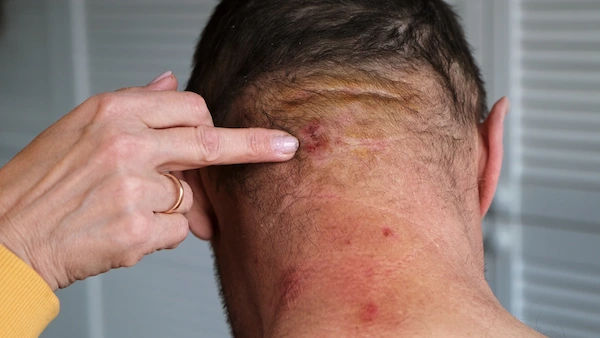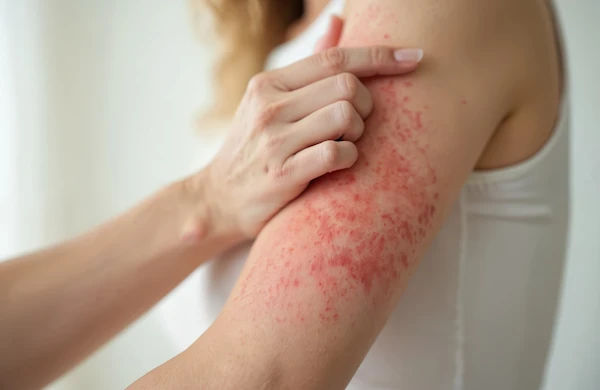All About Wheat Allergy
Explore all about wheat allergy—symptoms, causes, treatment, and more. A comprehensive understanding of wheat allergy can help avoid severe reactions or get the right treatment in case of accidental consumption.

Written by Dr Sonia Bhatt
Last updated on 3rd Jul, 2025
Wheat allergy is an adverse reaction to the proteins found in wheat. For some individuals, exposure to wheat through consumption or inhalation of wheat flour can trigger an abnormal immune response. Managing this condition often centres on avoiding wheat, but this can be challenging since wheat is found in a variety of food items.
In addition to understanding all about wheat allergy, one must also know how to distinguish wheat allergy from celiac disease. While both involve immune system responses, wheat allergy occurs when the body produces antibodies against wheat proteins, whereas celiac disease is an autoimmune disorder.
This article will explore the key aspects of wheat allergy, including its causes, symptoms, diagnosis and treatment options.
Causes of Wheat Allergy
Wheat allergy occurs when the immune system mistakenly identifies one of the four proteins in wheat as harmful. Normally, histamine is released by the body to fight off threats like parasites. However, in the case of wheat allergy, this response is triggered by otherwise harmless foods.
Genetics play a significant role in the likelihood of developing a wheat allergy. If you have a family history of allergies or allergic conditions like asthma or eczema, your risk of developing a food allergy, including one to wheat, is higher. This risk is even greater if both parents have allergies compared to having only one parent with allergic tendencies.
Symptoms of Wheat Allergy
Common symptoms include:
Hay fever-like reactions, such as nasal congestion or a runny nose
Asthma, with difficulty in breathing or wheezing
Skin conditions, including atopic dermatitis (eczema) or hives, an itchy rash that may involve swelling
Gastrointestinal issues, such as nausea, vomiting, diarrhoea, or constipation
Irritation or swelling in the mouth, throat, or both
These common symptoms can potentially escalate into severe, life-threatening reactions known as anaphylaxis. Symptoms of anaphylaxis include difficulty breathing, a sudden drop in blood pressure, swelling in the throat, and loss of consciousness.
Consult Top Dermatologists
Diagnosing Wheat Allergy
Some of the ways to diagnose wheat allergy include:
Skin Test: A skin test is often the first step in diagnosing wheat allergy. Tiny drops of purified allergen extracts, including wheat proteins, are placed on the skin—usually on the forearm or upper back—and then lightly pricked into the skin’s surface. After 15 minutes, the doctor or nurse will check for signs of an allergic reaction.
Blood Test: If a skin test isn’t suitable, such as when a skin condition or certain medications interfere with results, doctors may order a blood test. This test measures specific antibodies in the blood that react to common allergens, including wheat proteins.
Oral Food Challenge: If the results of other tests are inconclusive, allergists may recommend an oral food challenge. Under close medical supervision, the patient is asked to consume small amounts of wheat to monitor for any allergic reaction.
In addition to these methods, an accurate diagnosis also relies on a thorough study of medical history. Allergists ask about the patient's symptoms, exposure to wheat, and any family history of allergies. A strong family history of allergies increases the likelihood of developing a wheat allergy, especially if both parents are affected.
Consult Top Dermatologists
Treatment and Management
Here are some of the common ways to treat and manage a wheat allergy:
1. Strict Wheat Avoidance
Eliminate Wheat from the Diet: The most effective way to manage a wheat allergy is to completely avoid wheat in all forms, including wheat flour, bread, pasta, cakes, and processed foods that may contain wheat.
Identify Hidden Sources: Be vigilant about hidden wheat in sauces, processed meats, soups, gravies, and even some medications and cosmetics. Always check labels for wheat-based ingredients like wheat starch or malt.
2. Emergency Preparedness
Epinephrine (EpiPen): Always carry an epinephrine auto-injector in case of accidental exposure that leads to anaphylaxis, a severe allergic reaction. Ensure that family, friends, and caregivers know how to use it.
Medical ID: Consider wearing a medical alert bracelet to inform others about the allergy in case of an emergency.
Dietary Alternatives and Options
Individuals with a wheat allergy should avoid wheat-based products like bread, pasta, and baked goods, along with hidden sources in sauces and processed foods. They can replace wheat with alternatives such as rice, quinoa, oats (certified gluten-free), buckwheat, sorghum, millet, and flours made from almond, coconut, or potato. Wheat-free bread and pasta made from rice, chickpeas, or lentils are suitable substitutes.
A diet rich in naturally wheat-free foods like fruits, vegetables, lean proteins, and dairy is recommended. Labels should always be checked, and restaurant staff should be informed about the allergy.
Living with Wheat Allergy
Managing a wheat allergy requires awareness and careful planning, but with the right strategies, it’s completely manageable. Here are a few key tips:
Know Where the Wheat Hides: Learn about wheat derivatives such as wheat starch and semolina to avoid consuming them.
Check Labels: Always read labels for hidden wheat ingredients. While "gluten-free" is helpful, it doesn’t always mean wheat-free, so double-check.
Plan Ahead When Dining Out: When eating out, let the restaurant know about your allergy.
Advice for Parenting a Child with Wheat Allergy
Parenting a child with a wheat allergy requires a thoughtful, hands-on approach. Parents should educate their children about safe and unsafe foods, teaching them to read labels and understand their allergies. Preparing meals at home is key, which ensures safety and control. It's important to inform teachers, caregivers, and family members about the allergy and have a clear action plan in place.
Wheat Allergy vs. Celiac Disease vs. Gluten Sensitivity
Wheat allergy, celiac disease, and gluten sensitivity all involve reactions to wheat or gluten, but they have key differences. Here's a simple breakdown:
1. Wheat Allergy
Cause: This is an immune system response to proteins in wheat, such as gluten. The body treats wheat as a harmful substance.
Symptoms: Reactions can range from mild (hives, itching, swelling) to severe (anaphylaxis, difficulty breathing, and even shock).
Key Difference: A wheat allergy is an allergic reaction to wheat proteins, not just gluten.
2. Celiac Disease
Cause: Celiac is an autoimmune disorder where consuming gluten (found in wheat, barley, and rye) damages the small intestine and impairs nutrient absorption.
Symptoms: Digestive issues like diarrhoea and bloating, fatigue, skin rashes, and more serious long-term effects like osteoporosis if untreated.
Key Difference: Celiac disease causes long-term intestinal damage when gluten is consumed.
3. Gluten Sensitivity (Non-Celiac Gluten Sensitivity)
Cause: While the exact cause isn't fully understood, gluten sensitivity involves symptoms similar to celiac but without intestinal damage or allergic response.
Symptoms: Includes bloating, fatigue, joint pain, and digestive discomfort, but without the severe intestinal damage seen in celiac disease.
Key Difference: Unlike celiac disease, gluten sensitivity doesn't harm the intestines, and it's not caused by an allergic reaction to wheat.
Misdiagnosis concerns arise because wheat allergy, celiac disease, and gluten sensitivity share overlapping symptoms. Understanding the key differences is essential to follow the right preventive measures or treatment plans if needed.
Conclusion
Living with a wheat allergy requires vigilance and careful management. But with the right knowledge and planning, individuals can lead a healthy, fulfilling life.
Understanding wheat sources, reading labels, and preparing for emergencies are crucial steps in avoiding allergic reactions. By staying informed and making smart dietary choices, you can effectively manage your wheat allergy and minimise risks.
With ongoing research and advancements in treatment, better options for managing wheat allergies are continuously emerging.
Consult Top Dermatologists
Consult Top Dermatologists

Dr. Anju Mangla
Dermatologist
14 Years • MBBS, MD
Noida
Apollo Hospitals Sector 26, Noida

Dr. Anushtha Tomar
Dermatologist
10 Years • Md( Dermatology, Venereology, Leprosy )
Indore
Apollo Hospitals Vijay Nagar, Indore

Dr. K Chetana
Dermatologist
10 Years • MBBS, MD ( Dermatology)
Hyderabad
Apollo 24|7 Clinic, Hyderabad

Dr. Apoorva Raghavan
Dermatologist
7 Years • MBBS, MD (Derma Venereology & Leprosy)
Chennai
Apollo First Med Hospitals P H Road, Chennai
(50+ Patients)

Dr. Pranoti Deshpande
Dermatologist
5 Years • MBBS, MD (Dermatology, Venereology and Leprosy)
Hyderabad
Apollo Hospitals D R D O kanchanbagh, Hyderabad
(175+ Patients)
Consult Top Dermatologists

Dr. Anju Mangla
Dermatologist
14 Years • MBBS, MD
Noida
Apollo Hospitals Sector 26, Noida

Dr. Anushtha Tomar
Dermatologist
10 Years • Md( Dermatology, Venereology, Leprosy )
Indore
Apollo Hospitals Vijay Nagar, Indore

Dr. K Chetana
Dermatologist
10 Years • MBBS, MD ( Dermatology)
Hyderabad
Apollo 24|7 Clinic, Hyderabad

Dr. Apoorva Raghavan
Dermatologist
7 Years • MBBS, MD (Derma Venereology & Leprosy)
Chennai
Apollo First Med Hospitals P H Road, Chennai
(50+ Patients)

Dr. Pranoti Deshpande
Dermatologist
5 Years • MBBS, MD (Dermatology, Venereology and Leprosy)
Hyderabad
Apollo Hospitals D R D O kanchanbagh, Hyderabad
(175+ Patients)




